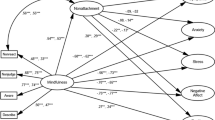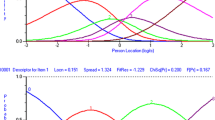Abstract
Nonattachment is a Buddhism-rooted construct, which can be defined as the relative absence of fixation on ideas, images, or sensory objects, as well as an absence of internal pressure to get, hold, avoid, or change circumstances or experiences. The present study was aimed at exploring the psychometric properties of the Spanish version of the Nonattachment Scale (NAS) and at delimitating the relationship between the NAS and measures of mindfulness, decentering, and negative emotional symptoms. Pooling the NAS data from Spanish meditators (n = 335) and nonmeditators (n = 270), we performed an exploratory factor analysis and then estimated the fit of two competing models (one-factor model vs. one-factor model + method effects) via confirmatory factor analysis. Data analyses showed that the Spanish version of the NAS is unifactorial in nature and has excellent internal consistency. As expected, high (positive) significant correlations were found between NAS and mindfulness and decentering measures, as well as high significant (negative) relations between NAS and depression, anxiety, and stress scores. Positive relations were also observed between NAS and variables of meditation practice. Large differences among the meditative, nonmeditative, and clinical groups (n = 39 patients with borderline personality disorder) were observed regarding NAS scores. Scores on the NAS were significant predictors of negative emotional symptoms (depression, anxiety, and stress) and, especially, resilience. Furthermore, NAS provided a unique contribution in the regression models, going beyond mindfulness facets and decentering. In conclusion, the Spanish version of the NAS is a psychometrically sound instrument with a promising future in the field of mindfulness and meditation research and in clinical settings.
Similar content being viewed by others
References
Aguado, J., Luciano, J. V., Cebolla, A., Serrano-Blanco, A., Soler, J., & García-Campayo, J. (2015). Bifactor analysis and construct validity of the five facet mindfulness questionnaire (FFMQ) in non-clinical Spanish samples. Frontiers in Psychology, 6, 404. doi:10.3389/fpsyg.2015.00404.
Allen, J. G. (2012). Mentalizing in the Development and Treatment of Attachment Trauma. Karnac Books
Baer, R. A., Smith, G. T., Hopkins, J., Krietemeyer, J., & Toney, L. (2006). Using self-report assessment methods to explore facets of mindfulness. Assessment, 13, 27–45.
Baer, R. A., Smith, G. T., Lykins, E., Button, D., Krietemeyer, J., Sauer, S., et al. (2008). Construct validity of the five facet mindfulness questionnaire in meditating and nonmeditating samples. Assessment, 15(3), 329–342. doi:10.1177/1073191107313003.
Bados, A., Solanas, A., & Andrés, R. (2005). Psychometric properties of the Spanish version of Depression, Anxiety and Stress Scales (DASS). Psicothema, 17, 679–683.
Bandalos, D. L., & Finney, S. J. (2001). Item parceling issues in structural equation modeling. In G. A. Marcoulides & R. E. Schumacker (Eds.), Advanced structural equation modeling: new developments and techniques (pp. 269–296). Mahwah: Lawrence Erlbaum.
Barrachina, J., Soler, J., Campins, M. J., Tejero, A., Pascual, J. C., Alvarez, E., et al. (2004). Validation of a Spanish version of the Diagnostic Interview for Bordelines-Revised (DIB-R). Actas Españolas de Psiquiatría, 32, 293–298.
Bergomi, C., Tschacher, W., & Kupper, Z. (2013). Measuring mindfulness: first steps towards the development of a comprehensive mindfulness scale. Mindfulness, 4(1), 18–32. doi:10.1007/s12671-012-0102-9.
Bishop, S. R., Lau, M., Shapiro, S., Carlson, L., Anderson, N. D., Carmody, J., et al. (2004). Mindfulness: a proposed operational definition. Clinical Psychology: Science and Practice, 11, 230–241. doi:10.1093/clipsy.bph077.
Brown, K. W., & Ryan, R. M. (2003). The benefits of being present: mindfulness and its role in psychological well-being. Journal of Personality and Social Psychology, 84, 822–848.
Brown, K. W., Ryan, R. M., & Creswell, J. D. (2007). Mindfulness: theoretical foundations and evidence for its salutary effects. Psychological inquiry, 18(4), 211–237. doi:10.1080/10478400701598298.
Cebolla, A., Garcia-Palacios, R., Soler, J., Guillen, V., Baños, R., & Botella, C. (2012). Psychometric properties of the Spanish validation of the Five Facets of Mindfulness Questionnaire (FFMQ). European Journal of Psychiatry, 26(2), 118–126. doi:10.4321/s0213-61632012000200005.
Connor, K. M., & Davidson, J. R. T. (2003). Development of a new resilience scale: the Connor-Davidson Resilience Scale (CD-RISC). Depression and Anxiety, 18, 76–82.
De Bruin, E. I., Topper, M., Muskens, J. G., Bögels, S. M., & Kamphuis, J. H. (2012). Psychometric properties of the Five Facets Mindfulness Questionnaire (FFMQ) in a meditating and a non-meditating sample. Assessment, 19(2), 187–197. doi:10.1177/1073191112446654.
Desbordes, G., Gard, T., Hoge, E. A., Hölzel, B. K., Kerr, C., Lazar, S. W., et al. (2015). Moving beyond mindfulness: defining equanimity as an outcome measure in meditation and contemplative research. Mindfulness, 6(2), 356–372. doi:10.1007/s12671-013-0269-8.
Desrosiers, A., Vine, V., Curtiss, J., & Klemanski, D. H. (2014). Observing nonreactively: a conditional process model linking mindfulness facets, cognitive emotion regulation strategies, and depression and anxiety symptoms. Journal of Affective Disorders, 165, 31–37. doi:10.1016/j.jad.2014.04.024.
Ferguson, C. J. (2009). An effect size primer: a guide for clinicians and researchers. Professional Psychology: Research and Practice, 40(5), 532. doi:10.1037/a0015808.
Fresco, D. M., Moore, M. T., van Dulmen, M. H., Segal, Z. V., Ma, S. H., Teasdale, J. D., & Williams, J. M. G. (2007a). Initial psychometric properties of the experiences questionnaire: validation of a self-report measure of decentering. Behavior Therapy, 38(3), 234–246. doi:10.1016/j.beth.2006.08.003.
Fresco, D. M., Segal, Z. V., Buis, T., & Kennedy, S. (2007b). Relationship of posttreatment decentering and cognitive reactivity to relapse in major depression. Journal of Consulting and Clinical Psychology, 75(3), 447–455.
Gratz, K. L., & Roemer, L. (2004). Multidimensional assessment of emotion regulation and dysregulation: development, factor structure, and initial validation of the difficulties in emotion regulation scale. Journal of Psychopathology & Behavioral Assessment, 26(1), 41–54.
Hervás, G., & Jódar, R. (2008). Adaptación al castellano de la Escala de Dificultades en la Regulación Emocional. Clínica Y Salud, 19(2), 139–156.
Leichsenring, F., Leibing, E., Kruse, J., New, A. S., & Leweke, F. (2011). Borderline personality disorder. The Lancet, 377(9759), 74–84. doi:10.1016/S0140-6736(10)61422-5.
Lovibond, P. F., & Lovibond, S. H. (1995). The structure of negative emotional states: comparison of the Depression Anxiety Stress Scales (DASS) with the Beck Depression and Anxiety Inventories. Behaviour Research and Therapy, 33, 335–343.
McIntosh, W. D., & Martin, L. L. (1992). The cybernetics of happiness: the relation between goal attainment, rumination, and affect. In M. S. Clark (Ed.), Review of Personality and Social Psychology (Vol. 14, pp. 222–146). Newbury Park: Sage Publications.
Notario-Pacheco, B., Solera-Martínez, M., Serrano-Parra, M. D., Bartolomé-Gutiérrez, R., García-Campayo, J., & Martínez-Vizcaíno, V. (2011). Reliability and validity of the Spanish version of the 10-item Connor-Davidson Resilience Scale (10-item CD-RISC) in young adults. Health and Quality of Life Outcomes, 9, 63. doi:10.1186/1477-7525-9-63.
Ritter, P., Lorig, K., Laurent, D., & Matthews, K. (2004). Internet versus mailed questionnaires: a randomized comparison. Journal of Medical Internet Research, 6, e29.
Safran, J. D., & Segal, Z. V. (1990). Interpersonal process in cognitive therapy. New York: The Guilford Press.
Sahdra, B. K., Shaver, P. H., & Brown, K. W. (2010). A scale to measure nonattachment: a Buddhist complement to Western research on attachment and adaptive functioning. Journal of Personality Assessment, 92(2), 116–127. doi:10.1080/00223890903425960.
Sahdra, B. K., Ciarrochi, J., Parker, P. D., Marshall, S., & Heaven, P. (2015). Empathy and nonattachment independently predict peer nominations of prosocial behavior of adolescents. Frontiers in Psychology, 6, 263. doi:10.3389/fpsyg.2015.00263.
Schumacher, R. E., & Lomax, R. G. (2010). A beginner’s guide to structural equation modeling (3rd ed.). Mahwah: Lawrence Erlbaum Associates.
Smith, G. T., McCarthy, D. M., & Anderson, K. G. (2000). On the sins of short-form development. Psychological Assessment, 12, 102–111.
Soler, J., Cebolla, A., Feliu-Soler, A., Demarzo, M. M., Pascual, J. C., Baños, R., et al. (2014b). Relationship between meditative practice and self-reported mindfulness: the MINDSENS composite index. PloS one, 9(1). doi: 10.1371/journal.pone.0086622
Soler, J., Franquesa, A., Feliu-Soler, A., Cebolla, A., García-Campayo, J., Tejedor, R., et al. (2014a). Assessing decentering: validation, psychometric properties and clinical usefulness of the Experiences Questionnaire in a Spanish sample. Behavior Therapy, 45(6), 863–71. doi:10.1016/j.beth.2014.05.004.
Steiger, J. H. (1980). Tests for comparing elements of a correlation matrix. Psychological Bulletin, 87, 245–251.
Tabachnick, B. G., & Fidell, L. S. (2007). Using multivariate statistics (5th ed.). Pearson Education: Boston.
Tanay, G., Lotan, G., & Bernstein, A. (2012). Salutary proximal processes and distal mood and anxiety vulnerability outcomes of mindfulness training: a pilot preventive intervention. Behavior therapy, 43(3), 492–505. doi:10.1016/j.beth.2011.06.003.
Teasdale, J. D., Moore, R. G., Hayhurst, H., Pope, M., Williams, S., & Segal, Z. V. (2002). Metacognitive awareness and prevention of relapse in depression: empirical evidence. Journal of Consulting and Clinical Psychology, 70(2), 275–287. doi:10.1037/0022-006x.70.2.275.
Wallace, B. A. (2005). Genuine happiness: meditation as the path to fulfillment. New York: Wiley.
Williams, M. J., Dalgleish, T., Karl, A., & Kuyken, W. (2014). Examining the factor structures of the five facet mindfulness questionnaire and the self-compassion scale. Psychological Assessment, 2, 407–418. doi:10.1037/a0035566.
Woods, C. M. (2006). Careless responding to reverse-worded items: implications for confirmatory factor analysis. Journal of Psychopathology and Behavioral Assessment, 28, 186–191. doi:10.1007/s10862-005-9004-7.
Wupperman, P., Neumann, C. S., Whitman, J. B., & Axelrod, S. R. (2009). The role of mindfulness in borderline personality disorder features. The Journal of nervous and mental disease, 197(10), 766–771. doi:10.1097/NMD.0b013e3181b97343.
Acknowledgments
This study was in part supported by CIBERSAM, CIBEROBN, REDIAPP (Instituto de Salud Carlos III, ISCIII; RD12/0005/0006 and RD12/0005/0008), and PROMOSAM (Red de Excelencia PSI2014-56303-REDT). We are also grateful to ISCIII for two grants for research projects on health (PI13/00134 and PI15/00383) that are co-financed with European Union ERDF funds. The third author (JVL) has a Miguel Servet contract awarded by the ISCIII (CP14/00087).
Author information
Authors and Affiliations
Corresponding author
Rights and permissions
About this article
Cite this article
Feliu-Soler, A., Soler, J., Luciano, J.V. et al. Psychometric Properties of the Spanish Version of the Nonattachment Scale (NAS) and Its Relationship with Mindfulness, Decentering, and Mental Health. Mindfulness 7, 1156–1169 (2016). https://doi.org/10.1007/s12671-016-0558-0
Published:
Issue Date:
DOI: https://doi.org/10.1007/s12671-016-0558-0




